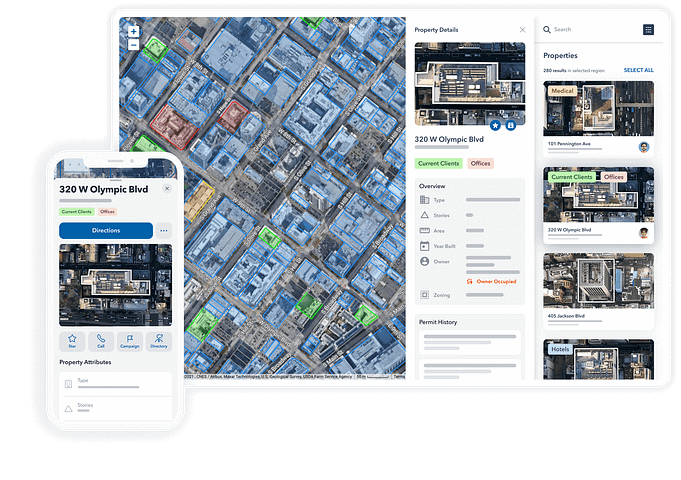Introduction
Innovation has completely changed the face of lead generation over the past couple of years, especially in B2B commercial services. Gone are the days of flipping through the Yellow Pages, cold calling, and hoping for the best.
Today, sales teams have access to powerful tools that make identifying and converting prospective customers easier than ever. At the forefront of this innovation are platforms like Convex, which use the power of Generative AI, intent data, sales intelligence data, and buying signals to supercharge lead-outbound generation efforts and accelerate sales.
These cutting-edge solutions are the answer to questions from commercial services owners and managers like, “What are the best sources for B2B Lead Generation today?”
That’s what we’re going to cover in this article.
We’ll do a deep dive into outbound lead generation, discuss the five must-have lead generation tools for B2B marketers and sales reps in the commercial services space, and discuss their features, benefits, and usability to help you build a lead-generation strategy that delivers results.

What is Lead Generation?
Many businesses are searching for B2B lead-gen tools. But before we jump into the tools, let’s define lead generation and how it works. Simply put, lead generation is the process of attracting and capturing leads and converting strangers into buyers for your company’s product or service.
This process covers a few stages (or steps). A traditional lead generation process includes six stages – five of which will be relevant to our conversation today.
Awareness: This is where you make prospects aware of your product or service.
Interest: At this stage, you take those who are interested and give them some information to nurture their interest.
Consideration: This is where you start to build a relationship with the potential buyer, answering their questions and giving them all the information they need.
Intent: This stage is all about understanding the buyer’s intent and knowing if they’re likely to make a purchase.
Evaluation: Once you know there’s intent, it’s time to engage with the buyer and address any remaining concerns or objections they may have before making a final decision.
Purchase: The final stage of the traditional lead generation process, where the potential buyer becomes an actual customer.
To ascend to the next step, the prospective customer needs something different at each step. For instance, they need education and product/service knowledge in the awareness phase. In the intent stage, however, they may require testimonials, a quote, or a “trial run” to fully evaluate the product/service before making a final decision.

The Importance of Outbound Lead Generation for B2B Commercial Services
Outbound lead generation is about creating predictable sales growth. To do this, you need to be able to acquire customers who are “on demand.”
According to the Data & Marketing Association, outbound lead generation tactics like email can generate a return on investment (ROI) of between 3600% and 5300% – that’s an average of 44:1 on average. For this reason and many others, an effective lead generation system is critical for driving revenue and growing your business.
Imagine this: you’re a commercial generator sales rep breaking into a new market. You’ve got a list of companies, names, and numbers to call. Who do you call first? How do you figure out who’s really interested so you can focus on the best opportunities? And most importantly, how long will it take you to start making sales?
For most, it could be weeks or months before your first sale. According to a recent LinkedIn pulse, the average sales rep takes 4.5 months to “fully ramp.” That means you’re covering their salary (going into the red) for at least a few months before seeing any return on investment (ROI).
However, the best lead generation tools can change that. You can use these tools to:
Quickly identify interested prospects using “buying signals.”
Leverage Intent data to pinpoint your hottest leads and prioritize them.
Employ Generative AI for outreach, eliminating guesswork and sending personalized, relevant messages based on their needs.
Enhance productivity with automation, accomplishing more in less time.
Generate high-quality, targeted lead lists.
Ensure follow-ups and lead nurturing sequences are never forgotten.
With these capabilities, outbound lead generation becomes significantly more efficient and effective. You can quickly identify the most promising opportunities and spend your time and resources converting those leads into customers.
Want to see how it works?
Jared Rothberger from JAN-PRO leverages Convex’s Atlas platform to streamline their commercial cleaning growth goals. With Convex’s sales intelligence, they spend way less time on lead research and prospecting and more time closing deals.
Thanks to best-in-class data and integrated buying signals, JAN-PRO can easily find and engage the hottest leads in their target market. They can also use Convex’s AI-powered outreach to send personalized, relevant messages that resonate with prospects and drive conversions.
For more details, you can watch the full testimonial here.

The 5 Must-Have Types of Lead Generation Tools for Outbound Lead Generation
So, what are the top 5 types of lead-generation tools you need in your lead-gen toolkit?
To successfully navigate each stage of the lead generation process, you need the right tools in your arsenal. Here are some essential tools that can help you nurture more leads, boost your conversion rates, and close more deals:
Property Intelligence (OR) Sales Intelligence Software: Property and sales intelligence tools like Convex and LinkedIn Sales Navigator allow you to uncover the right people, properties, or accounts that fit your ideal customer profile. With this information at your fingertips, you can reach out with the right message at the right time, increasing your chances of making a meaningful connection.
CRM (Customer Relationship Management) Software: A CRM like HubSpot or Pipedrive is the central hub where you manage all your leads and customer interactions. It helps you track lead status, communication history, and sales pipeline progress. With a CRM, you can ensure no lead falls through the cracks and that your team is always working on the most promising opportunities.
Email Marketing Platform: Email marketing is a critical component of lead nurturing. Platforms like Mailchimp and Ortto enable you to create and deploy targeted email campaigns that engage your leads and move them closer to a purchase decision. Look for tools with automation features that allow you to set up trigger-based emails that deliver the right content at the right time.
Sales Process Automation Tools: Tools like Zapier, Outreach, and Drift streamline your sales workflows by automating repetitive tasks such as lead assignment, follow-up emails, and appointment scheduling. This frees up your reps to focus on high-value activities like having conversations with decision-makers. Automation also ensures a consistent, timely process is followed for every lead.
Scheduling Tools: Scheduling tools like Calendly and ScheduleOnce eliminate the back-and-forth often required to book meetings with leads. Instead of lengthy email chains proposing different times, leads can easily view your availability and book a slot that works for them. This reduces friction in the sales process and makes it easier to connect with prospects.
With these five tools, you can find potential customers, send them personalized messages, add them to your sales pipeline, use data enrichment to understand how your products and services can help, and schedule an appointment once they’re interested.
Now, before we get into an actual list of tools and how to choose the right ones for your team, let’s build a lead generation workflow.
Before you invest in tech, you need to have a clear picture of your lead generation process. You want to be able to identify bottlenecks, which tasks take up most of your time, and how you can automate or improve those processes so you can focus your time and energy on the true moneymakers.

Building Your Outbound Lead Generation Workflow: A Step-by-Step Guide
Here’s your ultimate guide to building a powerful outbound lead-gen machine, step by step!

Step 1: Define Your Ideal Customer Profile (ICP)
A deep understanding of your target audience is the foundation of any successful outbound campaign. Take the time to develop detailed buyer personas that include:
Property Data (type of property, decision-makers, assets on the property (HVAC, roofing, elevators, etc.)
Demographics (age, location, job title, etc.)
Firmographics (industry, company size, revenue, etc.)
Pain points and challenges
Goals and objectives
Buying behavior and preferences
The more specific you can get, the better. A clear picture of your ideal customer will guide every other aspect of your outbound strategy.

Step 2: Select Your Outreach Channels
Determine the best channels to reach and engage your target audience based on your buyer personas. This could include:
Email
Cold calling
Social media (LinkedIn, Twitter, etc.)
Direct mail
Events and trade shows
Consider where your ideal customers spend their time and their preferred communication styles. You may need to experiment with different channels to find the right mix.
For many businesses, email is the #1 channel; that’s why Convex, LinkedIn Sales Navigator, Cognism, and other sales intelligence solutions use email as a primary way to connect with prospects.

Step 3: Develop Compelling Content and Messaging
To capture the attention of your target buyers, you need to lead with value. Create content and messaging that speaks directly to their pain points and offers helpful solutions. This could take the form of:
Personalized email sequences
Thought leadership blog posts or articles
Educational webinars or videos
Case studies or customer success stories
Gated content like eBooks or whitepapers
Your outreach should focus on starting a conversation rather than making a “hard sell.” Aim to pique their curiosity and position your brand as a trusted resource.

Step 4: Build Targeted Prospect Lists
Armed with your ideal customer profile, it’s time to build your prospect lists. Again, this is where tools like Convex come in handy. With a property intelligence platform, you can quickly identify decision-makers at your target accounts and access their accurate contact information. Some key data points to look for include:
Name and job title
Email address and phone number
Company name and website
Ownership, tenant, and management info
Permit data
Location and property details
Buying signals or intent data
The more targeted and accurate your prospect lists, the higher your chances of success. Regularly clean and update your data to ensure you’re always working with the best information.

Step 5: Execute Personalized Outreach at Scale
With your prospect lists in hand, it’s time to launch your outreach. The key is to personalize your messaging as much as possible while still leveraging automation to reach a large audience.
This process can be time-consuming and challenging. According to Salesforce, on average, 21%+ of a sales rep’s time is spent in this phase. That’s an average of 2 hours per day—2 hours that aren’t being used to close deals.
That’s why Convex uses Generative AI trained on all sorts of data. It pulls in intent data, buying signals, property info, and sales intelligence to craft personalized outreach messages tailored for each prospect.
Once you’ve sent a personalized message, you can place the prospect into a nurture sequence or add follow-up reminders as needed, which is what we’ll discuss next.

Step 6: Implement Lead Nurturing and Follow-Up
Not every lead will be ready to buy right away. That’s where lead nurturing comes in. Develop a system for staying in touch with qualified leads, providing valuable content over time, and gradually guiding them toward a purchase decision. This could involve:
Drip email campaigns
Retargeting ads
Educational webinars or events
Personal follow-up from sales reps
The goal is to keep your brand top-of-mind and build trust with potential buyers. Convex integrates with HubSpot and other top customer relationship management tools (CRMs) to help you track and manage these relationships- the platform also helps you enrich customer data so your insights are always up-to-date.

Step 7: Track, Analyze, and Optimize
Finally, regularly track and analyze your outbound efforts to see what’s working and what’s not. Key metrics to monitor include:
Open and click-through rates
Response and conversion rates
Cost per lead and customer acquisition costs
Sales cycle length and deal size
Revenue per platform/ channel
Use this data to spot areas for improvement. Your subject lines may need a little tweak, or your call scripts could need a minor adjustment. Keep testing and fine-tuning your approach to get the best results.
By following this workflow step-by-step and using the right tools, you can create an outbound lead generation machine that consistently delivers solid results. It takes effort and some trial and error, but the pipeline and revenue growth rewards are worth it.
Now, let’s talk about the tools.

Top 7 Lead Generation Platforms for Commercial Services
1. Convex
Convex is the only lead generation software purpose-built for commercial services sales and marketing teams. Generating new leads on the platform is a breeze:
Pinpoint the Account, Job title, or Property that aligns with your offerings—this could be anything from a property manager to a hospital.
Check the Lead Scores to see who’s primed to buy.
Use Generative AI trained on their buying signals in just two clicks to send a tailored message.
Set up an automated follow-up sequence or reminder.
In short, Convex is your “one-stop-shop” for commercial services crews looking to amplify lead generation and sales without the complexity.
Our solution provides comprehensive property intelligence data, like permit history and tenant info, plus contact details for the decision-makers.
We’ve incorporated intent data, or “buying signals,” to indicate how likely a lead is to make a purchase, as well as Generative AI tools to assist with outreach. This means your sales reps can identify and contact a lead in under five minutes.
Plus, Convex is rated 4.6/5 on Capterra and offers “data enrichment,” filling in missing information or updating stale details to keep your lead database and CRM accurate. This saves you time and effort while boosting the quality of your leads—and it integrates perfectly with our next tool, Hubspot.
2. HubSpot
HubSpot is a comprehensive marketing automation and CRM platform that streamlines business lead generation and customer management. It offers tools for email marketing, social media management, content creation, and landing page design alongside powerful analytics for tracking performance. HubSpot also integrates perfectly with Convex, allowing sales reps to have best-in-class access to data and a sales pipeline tracking tool that keeps them up to date with leads at each stage of the sales cycle.
All-in-one marketing, sales, and customer service platform
4.4/5 on G2
Feature-rich but can be pricey for small businesses
Users laud its ease of use and positive client feedback
3. Zapier
Zapier is an automation tool that connects various web applications, enabling users to automate repetitive tasks without needing to code. By creating workflows, or “Zaps,” users can seamlessly integrate their different lead generation and marketing software tools, saving time and enhancing productivity across their sales processes.
Automation platform for integrating lead generation tools.
4.5/5 on G2 ⭐
Customizable zaps for various tasks
A wide range of integrations is available
4. Mailchimp
Mailchimp is a popular email marketing platform that enables businesses to design, send, and analyze email campaigns with ease. Powerful automation features and audience segmentation tools help users engage with their leads effectively and nurture customer relationships for better conversion rates.
Email marketing and automation platform
4.3/5 on G2
Intuitive email builder
Generous free plan
Some limitations with CRM and reporting
5. Calendly
Calendly is an online scheduling tool that simplifies the process of setting up meetings with leads and clients. By allowing users to share their availability, Calendly eliminates the back-and-forth emails often required to coordinate a meeting time. This streamlining enhances efficiency for sales teams, enabling them to spend more time engaging with leads rather than managing their schedules. Key features include customizable event types, automated reminders, and integration with calendar applications to ensure that all meetings are seamlessly tracked.
User-friendly scheduling tool
4.6/5 on G2
Integrates with popular calendars like Google and Outlook
Offers a free plan with essential features and premium plans for advanced functionality
6. Salesforce
Salesforce is a leading customer relationship management (CRM) platform that effectively helps businesses manage customer interactions and sales processes. With its extensive features for lead generation, opportunity management, lead capture, and analytics, Salesforce provides a robust foundation for businesses looking to enhance their sales strategies. The platform allows for custom reporting and dashboards, giving insights into sales performance and customer behaviors, which can inform future marketing strategies.
Comprehensive CRM solution
4.4/5 on G2
Highly customizable with a wide range of third-party integrations
Can be complex for new users, requiring some training
7. LinkedIn Sales Navigator
LinkedIn Sales Navigator is specifically designed for sales professionals to enhance their prospecting and relationship-building efforts. This premium tool provides advanced search capabilities, personalized algorithm-driven recommendations, and insights into extended networks, enabling users to identify and connect with high-quality leads. With its focus on social selling, Sales Navigator helps sales teams leverage their LinkedIn presence effectively.
Powerful prospecting tool for LinkedIn users
4.5/5 on G2
Real-time updates on leads and accounts
Subscription-based pricing may not suit all budgets
With Calendly in your marketing toolkit, you can ensure that connecting with leads is as easy and effective as possible, further improving your lead generation and sales processes. As you implement these tools into your strategy, watch as the efficiency and success of your outbound efforts increase, driving greater results for your business.

Choosing the Right Lead Generation Tool
In the world of “lead generation,” there are tons of tools. The ones we love might not even be on your radar. How do you decide which lead-generation tools are right for your business? Well, here are some key factors to consider:
Ease of use: The tool should be intuitive and easy for your team to adopt.
Accessibility: Cloud-based solutions allow you to work from anywhere.
Affordability: Look for a tool that fits your budget while delivering strong ROI.
Integrations: The tool should play nicely with the other software you use.
Support: Check reviews to ensure the vendor offers reliable customer service.
Features: Consider which features are essential for your business and whether the tool offers them.
Ultimately, the best lead-generation tools will depend on your specific needs and goals. Take the time to research and test out different options to find what works best for your team.
Once you’ve selected a tool, here are some tips for getting the most out of it:
Start with a demo or free trial to test drive the features and user experience
Integrate the tool with your CRM and other key platforms so you can learn the workflow
Provide training for your sales and marketing teams on how to use it effectively
Regularly review performance metrics and optimize your usage over time
These tips, along with the right lead generation and marketing tools used, will help you streamline prospecting, supercharge your sales efforts, and accelerate revenue for your business.

Conclusion
Lead generation is the fuel that keeps your business growth engine running. By leveraging the right mix of tools and tactics, you can fill your pipeline with high-quality prospects and empower your sales team to close more deals. The five key types of lead generation tools every B2B business needs are:
Property & sales intelligence software to find your ideal customers
CRM to track and manage your leads
Email lookup and outreach tools to connect with decision-makers
Scheduling tools
Sales and Marketing automation tools to nurture leads and automate tasks
These tools will help you identify the right buyers at the right time and send messages that are relevant to them.
Ready to jumpstart your lead-gen engine? Don’t let your competition get the edge. Invest in the tools and processes you need to make lead generation your competitive advantage.Schedule a demo of Convex today to discover how our comprehensive suite of B2B lead generation software and sales intelligence tools can revolutionize your sales process, save time, and drive more qualified sales leads to your business.
Share





